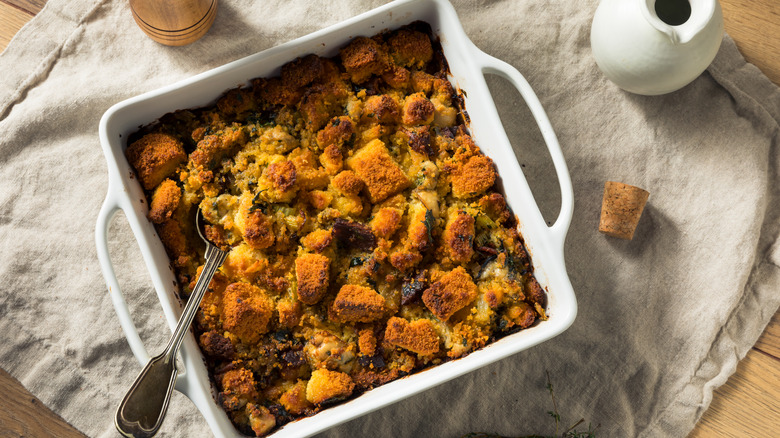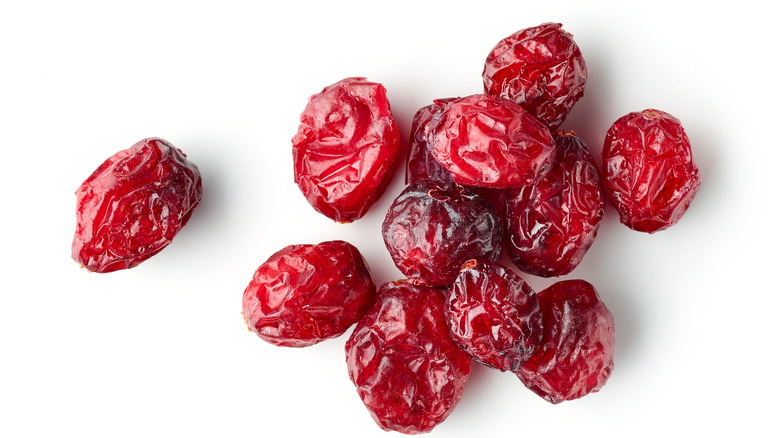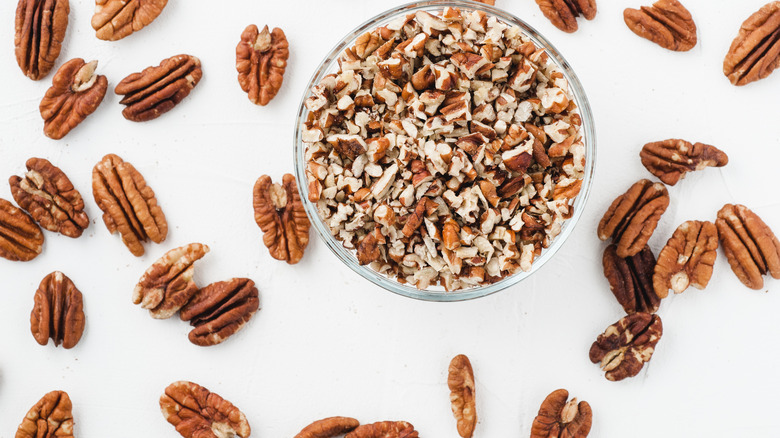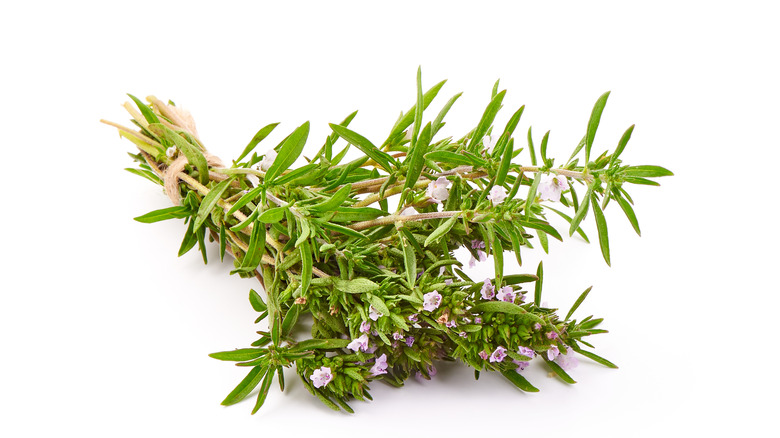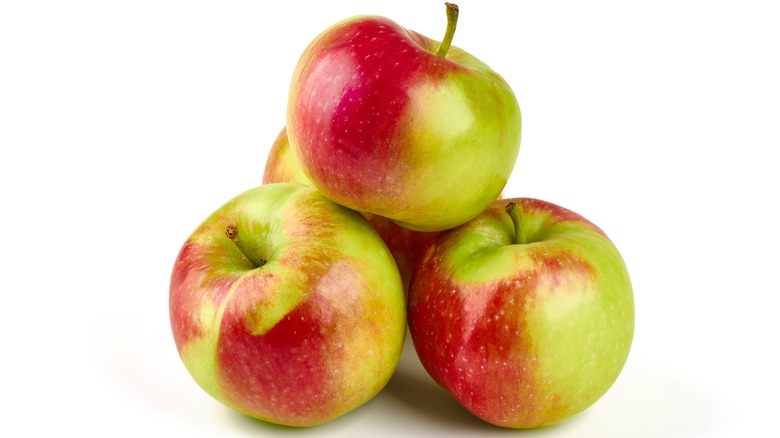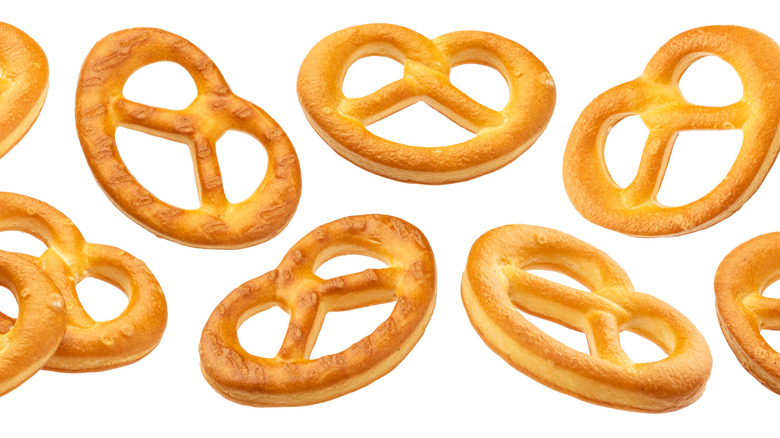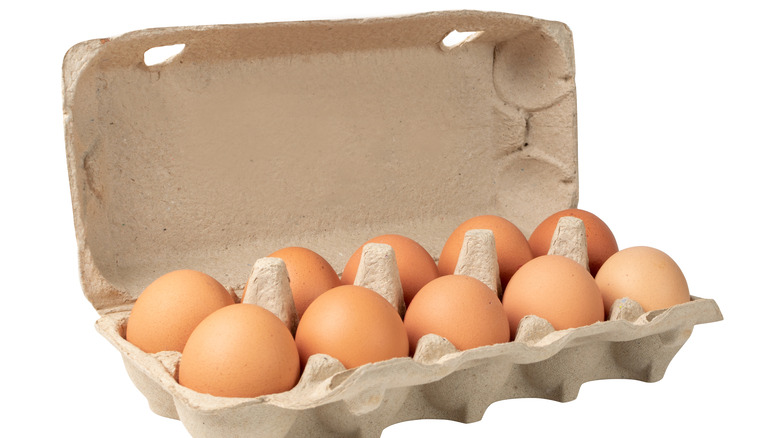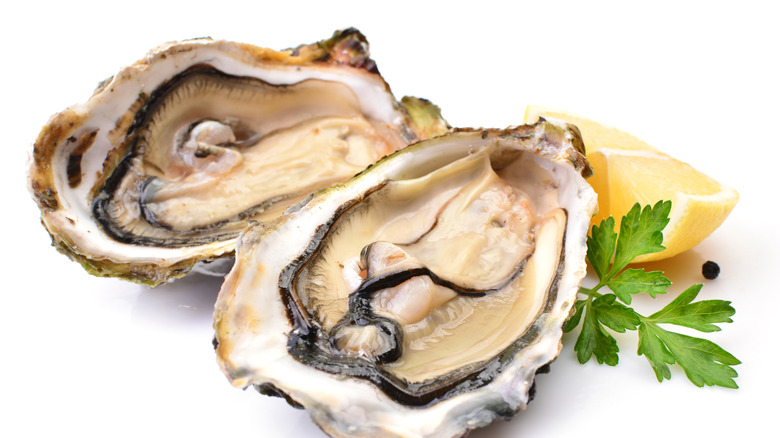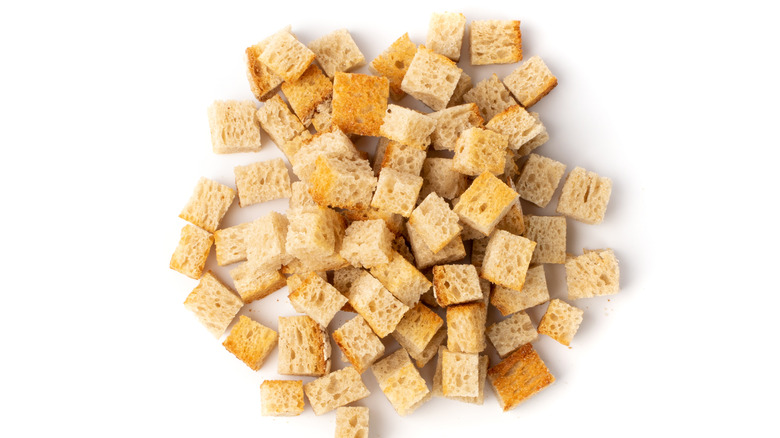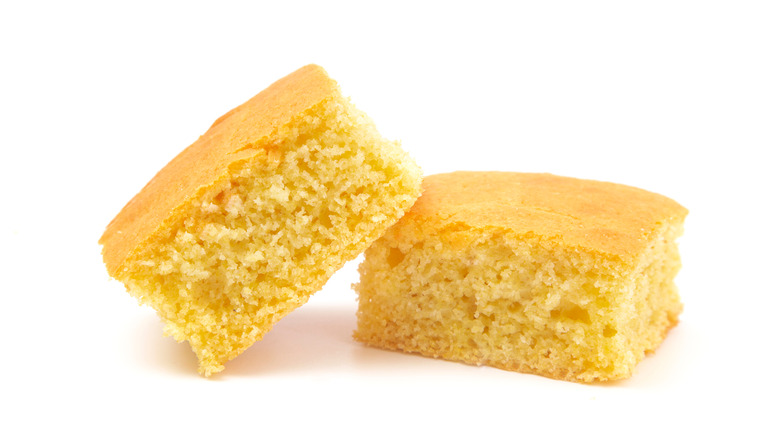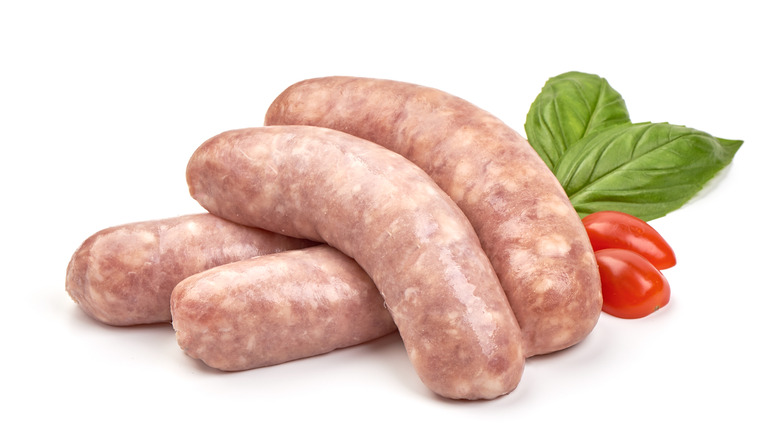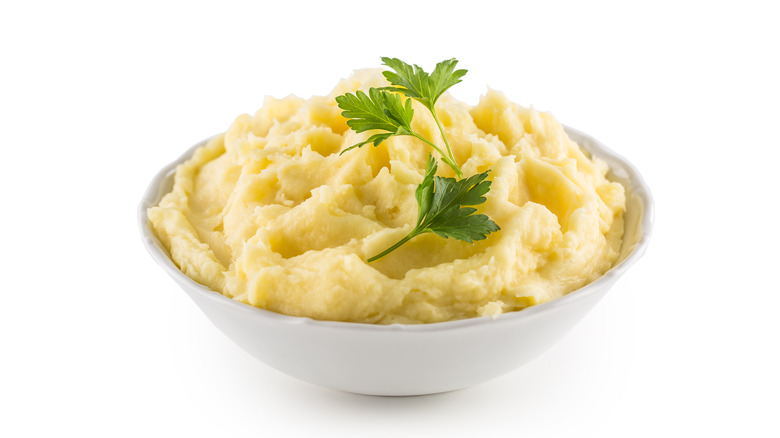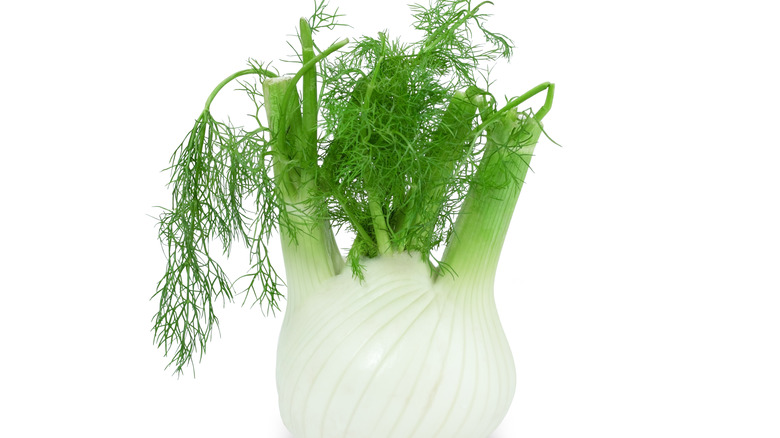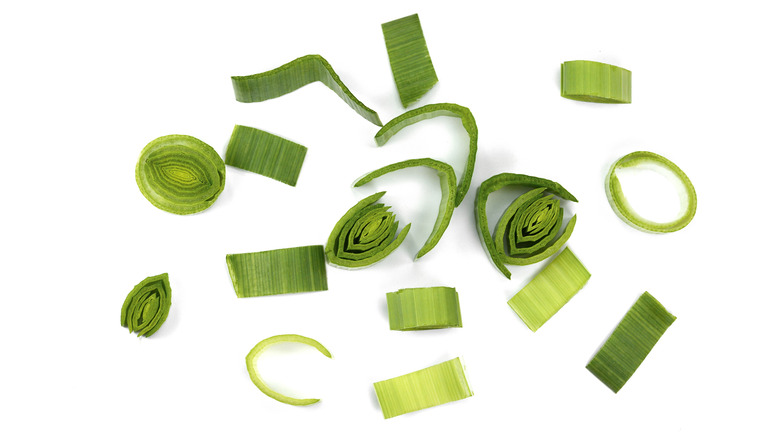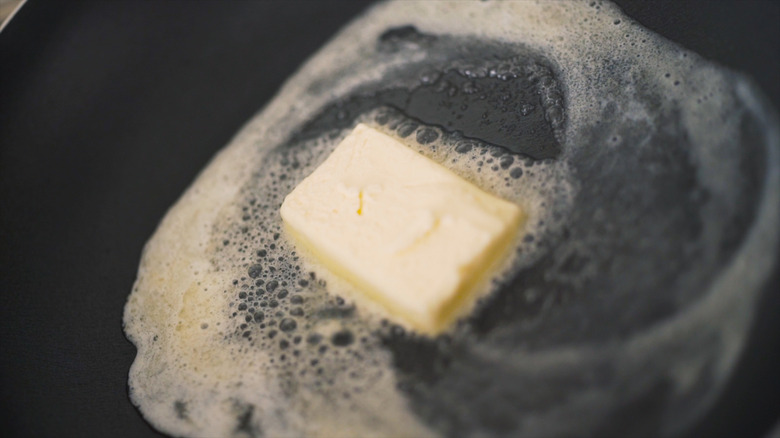15 Best Ingredients To Add To Your Stuffing
If there's one food that should always have a seat at the table on Thanksgiving, it's stuffing. Stuffing, by definition, is a filling put into another food (such as cooking your stuffing inside of a turkey). Dressing, in turn, is cooked separately from other foods. While stuffing and dressing are technically different, both usually contain a mix of bread products, diced vegetables, broth, herbs, and spices, so they're also very similar. No matter which you're cooking, sticking to just those basic ingredients is a typical stuffing or dressing mistake. You can create an absolutely amazing side dish with a bit of creativity.
If you want to make exceptional stuffing for your Thanksgiving dinner, you'll want to venture over untraveled terrain with the help of some nontraditional stuffing ingredients. You can find our recommendations at most major grocery stores, but you may have to journey outside the designated Thanksgiving and holiday food aisle. Here are our favorite ingredients to add to your next round of stuffing. They're guaranteed to have your dinner guests coming back for more!
1. Dried fruits
Stuffing can quickly turn into a soggy plate of bread. But what happens when you add dried fruit? You're looking to score an A+ on texture and variety.
Unequivocally, cranberries are our favorite fruit to add to this autumn country bread stuffing recipe. The dried cranberries will soak up some moisture from the broth and vegetables and become more pliable as the stuffing cooks. Plus, the cranberries won't add an obtrusive flavor that contradicts the rest of the stuffing ingredients. If you're thinking about adding dried cranberries to your stuffing, we recommend purchasing unsweetened dried cranberries rather than the sweetened kind commonly found in trail mix.
Other dried fruit options for your stuffing include raisins (golden raisins provide a bright boost of color), dried apricots, and dried figs. For the larger fruits, like apricots and figs, use your knife and cutting board to dice the fruit into tiny pieces before mixing them with the rest of your stuffing ingredients.
2. Chopped nuts
Chopped nuts, including pecans and walnuts, are another textural avenue for your stuffing recipes. Adding chopped nuts to your next stuffing carries multiple health benefits as well. According to the American Heart Association, pecans are a "standout nut" because of numerous phytochemicals that reduce inflammation. They're also high in fiber and fat, promoting satiety and making your stuffing a little more filling. Walnuts and slivered almonds are also great additions to stuffing when you want a mild nutty taste and a powerful dose of plant-based fats and protein.
If you plan on adding nuts to the stuffing, you'll want to mix the chopped nuts in right before you place the stuffing in the oven. Raw nuts are better suited for stuffings than previously roasted nuts because they will get nice and toasty when cooked with the bread and vegetables. Plus, roasting nuts before adding the pieces to your stuffing can emit too many burnt notes that may disrupt the stuffing's flavor.
3. Fresh herbs
If you're making stuffing and need seasonings at the moment, you might reach into your spice cabinet for thyme, sage, parsley, and the like. But, especially as far as stuffing goes, a little extra planning will result in a better flavor.
If you're working from a recipe, there are some things you need to know before you swap fresh herbs for dried herbs (and vice versa). First, dried herbs are much more potent than their fresh counterparts. A general rule of thumb is that one tablespoon of fresh herbs is equivalent to about a teaspoon of dried herbs.
Not only should you pay attention to the amount of herbs you add to your stuffing, but you should also be wary of the impact of the timing on the flavor of the herbs. It's often best to add fresh herbs as a garnish for your stuffing rather than mixing the fresh leaves in with the bread and vegetables. You'll get a much more full-bodied flavor and add a bright boost of color to an otherwise neutral-colored dish.
4. Apples
Apples are a sweet, mild fruit that beautifully contrasts the flavors of sausage, sage, and thyme. This makes the apple the perfect addition for a flavorful fall stuffing!
If you're wondering what types of apples to use for stuffing, think of baking apples. Granny Smith apples provide a strong tang to your stuffing and do not tend to lose their shape when baked, while Golden Delicious apples offer a sweeter undertone easily infused with herbs and flavors. Stay clear of softer apple varieties like the McIntosh and waxy Red Delicious. Fleshy apples tend to mush when baked, while the flavors of Red Delicious apples are too plasticky for a soft, flavorful stuffing.
Whichever apple you choose, you should make sure to peel and core it before adding it to the stuffing. No one likes getting strings of apple peel in their teeth, and the texture may disrupt the rest of the dish.
5. Pretzels
Stuffing is instinctually thought of as including bread, but did you know you can add other ingredients to provide a similar texture? If you have yet to try adding crushed pretzels to your stuffing recipe, now is a perfect time to give it a shot.
The Practical Kitchen recommends adding chunks of soft pretzels, as well as pretzel roll cubes, to stuffing instead of bread. While you can stick to the twisty pretzels alone, adding cubed pretzel rolls provides some variation and absorbs more of the stuffing's liquid. The Practical Kitchen also suggests using stale pretzels and pretzel bread, so be sure to check the clearance section at your local bakery. When slicing the pretzels, you'll find that this stuffing works best when you expose the innermost "flesh" of the pretzel rather than just the hard exterior since the inside of the bread is what is going to soak up the broth.
6. Eggs or binding ingredients
If you've noticed your stuffing is crumbly, it's a good idea to reevaluate your use of binders. Popular binders for stuffing include eggs, milk, and butter. The function of these ingredients is simple: allow the bread to adhere to the other components and keep the stuffing in one cohesive block (think casserole 101).
When working with binders in your recipe, consider the type and age of the bread you plan to use as well. Stale bread tends to soak up liquids (including binders) much better than fresh bread. If you need bread in a pinch, we recommend checking out the day-old section of a local bakery.
When adding the broth and the binders to the bread mixture, take your time. The best approach is to slowly add the broth in stages, allow the bread to absorb it, then continue adding more broth (similar to the cooking method for risotto). Stop when the bread no longer soaks up the broth and liquid pools at the bottom of the pan.
7. Oysters
If shellfish makes you queasy, stay away from this tasty addition to your stuffing. Oyster dressing is a traditional Southern side dish for holidays and celebrations. The soft flesh of the oyster provides an extra boost of moisture as well as a straight-from-the-sea saltiness you won't find in other ingredients.
Chef and author John Currence recommends using Blue Point oysters for his oyster dressing recipe. According to Pangea Shellfish, the Blue Point oyster is harvested from the shores of Long Island Sound and boasts a "springy texture" with a light mineral taste. Currence cooks the oysters with butter, bay leaves, thyme, black pepper, sage, and red pepper flakes for a savory and light heat before deglazing the pan with white wine. The secret to using oysters for a dressing is to make sure the other flavors in the dish are compatible with the brine of the oyster. Garlic, butter, and a splash of Tabasco are important in elevating the oyster's natural in a Southern dressing.
8. Gluten-free bread
We're all about making stuffing more accessible for the masses, which is why we recommend trying to make gluten-free stuffing for your next holiday gathering. Gluten-Free Palate recommends using Canyon Bakehouse Heritage Style loaves for stuffing because the bread is soft and pliable and absorbs the liquid ingredients remarkably well. Schär's Gluten-Free Artisan Baker White Bread is another of our favorite gluten-free breads.
Regardless of your chosen brand, you should always use stale bread for stuffing because it soaks up the broth and binders more efficiently. Baking Kneads suggests cubing the bread into pieces while it's fresh and leaving the bread exposed on the counter for two or three days. You can also try an oven-dried method if you're in a hurry. If you choose to use frozen gluten-free bread, you will have to tack on extra time to account for thawing the bread. Most recipes use a one-to-one ratio of gluten-free bread for traditional wheat bread.
9. Jalapeño peppers
Don't underestimate the power of spice in your stuffing, nor how important a fresh crunch is amid a sea of soft bread. That's why we're turning to jalapeños as a favorite ingredient to add to stuffing. Eli Kulp's bacon and jalapeño stuffing is packed with heat and flavor thanks to two diced peppers.
To reduce the spiciness and ensure a balanced flavor in your stuffing, remove the membrane and seeds of the jalapeños before dicing. According to the American Chemical Society, the oil trapped in these parts of the pepper contains capsaicin. This chemical causes the burning sensation when we eat chili peppers like the jalapeño, ghost pepper, or ancho chili.
One method that makes seeding chili peppers much easier is cutting the top (stem-end) of the pepper off before scooping out the seeds and membrane. Use gloves and avoid touching your eyes to minimize exposure to the burning feeling of indirectly making contact with capsaicin.
10. Cornbread
Southern cornbread is a food that drips warmth and comfort, making it the perfect ingredient to add to a stuffing or dressing. The graininess of cornbread can be a turn-off for some folks, but we think that adding this simple bread to your stuffing results in a wider diversity of textures. The broth, milk, and eggs are essential when making cornbread dressing because once the cornbread is crumbled, it can easily get drowned out by the vegetables or meats you add to the stuffing.
If you're looking for an easy route when making this stuffing at home, you can purchase store-bought or boxed cornbread for your dressing. Or, if you feel the urge to make your own cornbread, we recommend letting your cornbread cool on the rack for at least an hour before crumbling. Like other types of bread used in stuffings and dressings, the crumbled cornbread should sit on the counter for at least a day before you add them to your stuffing.
11. Sausage
There are so many different kinds of sausage; how can you pick the right one for your stuffing? While you can use any variety for sausage stuffing, recipe developer Erin Johnson recommends using a sage sausage. In that recipe, the flavor of the sage is amplified with other flavorful additions like Granny Smith apples and poultry seasoning. Other types of sausage you may consider for your stuffing include andouille (paired with cornbread) and hot or sweet Italian sausage (paired with apples, red pepper, and aromatic herbs like sage).
If you plan to add sausage to your stuffing, you need to allocate enough time to cook the sausage before adding it to the rest of the stuffing ingredients. Browning the sausage will boost its flavor and ensure that your finished stuffing doesn't have raw chunks of meat. You should also mince the sausage into tiny pieces to avoid disrupting the taste of the rest of the stuffing.
12. Mashed potatoes
Why make a separate plate of mashed potatoes when you can combine the two best Thanksgiving sides in one recipe? Mashed potatoes can act as an excellent intermediary for carbohydrate-loaded stuffing. According to Amish Heritage, the Amish started using potatoes in an "Amish potato filling" as a side dish to the stuffed turkey. Unlike stuffing or dressing, both of which can be cooked in the cavity of poultry or meat, this filling must be served as a side dish.
Furthermore, if you plan to make a hybrid mashed potato and stuffing dish at home, you should be prepared to use equal parts potato cubes and bread. The potatoes are mashed before adding the cubed bread and vegetables to the mix, so the dish can be easily modified to include boxed mashed potato mix rather than made-from-scratch mashed potatoes. Fresh herbs like thyme and sage go a long way with this tasty stuffing addition, and to finish it off with perfection, add a drizzle of gravy on top.
13. Roasted fennel
Fennel is a member of the carrot family that has several edible parts: the seeds, the feathery leaves, and the bulbous base. Roasted fennel is the key to making a flavorful stuffing because it retains its celery-like texture with a more profound flavor than other root vegetables. Plus, fennel is compatible with other vegetables, spices, and meats you typically find in stuffing, including diced carrots, onions, sage, and sausage.
We recommend dicing the fennel into tiny pieces before adding it to your stuffing with the rest of the vegetables. You can also caramelize fennel by tossing thinly sliced fennel into a hot pan with a bit of oil or unsalted butter before mixing the pieces with the vegetables. For a quick boost of fennel flavor, you can purchase a fennel-spiced sausage to add to your stuffing recipe or toss in a few teaspoons of fennel seeds when your sausage is cooking in the pan.
14. Leeks
The leek is a humble allium that isn't as common in stuffing recipes as you'd think. The leek's flavor is milder than a yellow onion, with a similar consistency to a scallion. If you prefer a less pungent onion flavor, you can replace onions with thinly chopped leeks in your stuffing recipe. We recommend combining the leek with other aromatic spices like bay leaves, fennel, and sage to amplify its flavor.
Before you go right ahead and dice up this veggie, you will need to properly clean the leeks. Start by chopping off the dark green parts of the leek; it won't cook down with the rest of the vegetables anyway. After trimming the ends, slice the leek in half to expose the interior folds. Swirl the leeks in a big bowl of water to remove any pesky pieces of sand or dirt before chopping and adding to your favorite homemade stuffing recipe.
15. Brown butter
One of the biggest mistakes folks make when it comes to stuffing is not adding enough butter. Not only does it act as a binder for the bread and add-ins, but butter also infuses a ton of flavor into the stuffing. And, if you're looking to enhance the butter flavor in your favorite stuffing recipe, you should look no further than brown butter.
The caramel flavors of brown butter come from a chemical reaction when the sugars and proteins in butter react to heat (via America's Test Kitchen). In essence, making brown butter toasts the milk solids in the butter, resulting in a dark, oaky flavor that amps up everything from chocolate chip cookies to roasting meats — and now stuffing!
Brown butter is easy to make at home. You just need to expose the butter to medium heat on a stove until the butter turns a light shade of brown and emits a nutty aroma. Then, substitute it for an equal part of the butter in your stuffing recipe.
